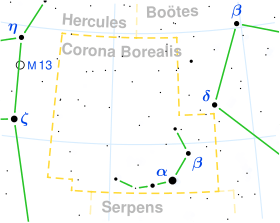Rho Coronae Borealis
Rho Coronae Borealis (ρ CrB, ρ Coronae Borealis) is a solar twin, yellow dwarf star approximately 57 light-years away in the constellation of Corona Borealis. The star is thought to be similar to the Sun with nearly the same mass, radius, and luminosity. In 1997, an extrasolar planet was announced on the basis of radial velocity measurements. This detection method gives only a minimum mass on the planet. Follow-up studies with the Hipparcos satellite indicate that the companion is actually a low-mass star in a nearly face-on orbit.[4]
 | |
| Observation data Epoch J2000.0 Equinox J2000.0 | |
|---|---|
| Constellation | Corona Borealis |
| Right ascension | 16h 01m 02.662s[1] |
| Declination | +33° 18′ 12.63″[1] |
| Apparent magnitude (V) | 5.4[2] |
| Characteristics | |
| Spectral type | G0V[3] |
| B−V color index | 0.61 |
| Astrometry | |
| Radial velocity (Rv) | 18.4 km/s |
| Proper motion (μ) | RA: −196.63±0.24[1] mas/yr Dec.: −773.02±0.21[1] mas/yr |
| Parallax (π) | 58.02 ± 0.28[1] mas |
| Distance | 56.2 ± 0.3 ly (17.24 ± 0.08 pc) |
| Absolute magnitude (MV) | +4.21[2] |
| Details | |
| Mass | 0.91[3] M☉ |
| Radius | 1.3617±0.0262[3] R☉ |
| Luminosity | 1.7059±0.0423[3] L☉ |
| Surface gravity (log g) | 4.12[2] cgs |
| Temperature | 5627±54[3] K |
| Metallicity [Fe/H] | -0.24 (± 0.08)[2] dex |
| Rotational velocity (v sin i) | 1.0[2] km/s |
| Age | 10.2[2] Gyr |
| Other designations | |
| Database references | |
| SIMBAD | data |
Stellar components
Rho Coronae Borealis is a solar analog, yellow dwarf star of the spectral type G0-2Va. The star is thought to have only 95 percent of the Sun's mass, along with 1.31 times its radius and 1.61 of its luminosity. It may only be 51 to 65 percent as enriched with elements heavier than hydrogen (based on its abundance of iron) and may be somewhat older than the Sun at around six billion years old.
A companion, initially thought to be an extrasolar planet in a 39.6-day orbit, was discovered in 1997 by observing the star's radial velocity variations.[5] This detection method only gives a lower limit on the true mass of the companion. In 2001, preliminary Hipparcos astrometrical satellite data indicated that the orbital inclination of the star's companion was 0.5°, nearly face-on, implying that its mass was as much as 115 times Jupiter's.[6] This was confirmed in 2011 using a new reduction of the astrometric data, with an updated mass value of 169.7 times Jupiter, with a 3σ confidence region 100.1 to 199.6 Jupiter masses.[4] Such a massive body would be a dim red dwarf star, not a planet.
Searches for circumstellar material
In October 1999, astronomers at the University of Arizona announced the existence of a circumstellar disk around the star.[7] Follow-up observations with the Spitzer Space Telescope failed to confirm this detect any infrared excess at 24- or 70-micrometre wavelengths, which would be expected if a disk were present.[8][9][10] No evidence for a disc was detected in observations with the Herschel Space Observatory either.[11]
See also
References
- van Leeuwen, F. (2007). "Validation of the new Hipparcos reduction". Astronomy and Astrophysics. 474 (2): 653–664. arXiv:0708.1752. Bibcode:2007A&A...474..653V. doi:10.1051/0004-6361:20078357. Vizier catalog entry
- Fuhrmann, Klaus; Pfeiffer, Michael J.; Bernkopf, Jan (1998). "F- and G-type stars with planetary companions: Upsilon Andromedae, rho (1) Cancri, tau Bootis, 16 Cygni and rho Coronae Borealis". Astronomy and Astrophysics. 336: 942. Bibcode:1998A&A...336..942F.
- von Braun, Kaspar; et al. (2014). "Stellar diameters and temperatures - V. 11 newly characterized exoplanet host stars". Monthly Notices of the Royal Astronomical Society. 438 (3): 2413–2425. arXiv:1312.1792. Bibcode:2014MNRAS.438.2413V. doi:10.1093/mnras/stt2360.
- Reffert, S.; Quirrenbach, A. (2011). "Mass constraints on substellar companion candidates from the re-reduced Hipparcos intermediate astrometric data: nine confirmed planets and two confirmed brown dwarfs". Astronomy & Astrophysics. 527. id.A140. arXiv:1101.2227. Bibcode:2011A&A...527A.140R. doi:10.1051/0004-6361/201015861.
- Noyes, Robert W.; et al. (1997). "A Planet Orbiting the Star ρ Coronae Borealis". Astrophysical Journal. 483 (2): L111–L114. arXiv:astro-ph/9704248. Bibcode:1997ApJ...483L.111N. doi:10.1086/310754.
- Han, Inwoo; Black, David C.; Gatewood, George (2001). "Preliminary Astrometric Masses for Proposed Extrasolar Planetary Companions". The Astrophysical Journal. 548 (1): L57–L60. Bibcode:2001ApJ...548L..57H. doi:10.1086/318927.
- Trilling, D. E.; Brown, R. H.; Rivkin, A. S. (2000). "Circumstellar Dust Disks around Stars with Known Planetary Companions". The Astrophysical Journal. 529 (1): 499–505. Bibcode:2000ApJ...529..499T. doi:10.1086/308280.
- Beichman, C. A.; Bryden, G.; Rieke, G. H.; Stansberry, J. A.; Trilling, D. E.; Stapelfeldt, K. R.; Werner, M. W.; Engelbracht, C. W.; et al. (2005). "Planets and Infrared Excesses: Preliminary Results from a Spitzer MIPS Survey of Solar-Type Stars". The Astrophysical Journal. 622 (2): 1160–1170. arXiv:astro-ph/0412265. Bibcode:2005ApJ...622.1160B. doi:10.1086/428115.
- Bryden, G.; Beichman, C. A.; Carpenter, J. M.; Rieke, G. H.; Stapelfeldt, K. R.; Werner, M. W.; Tanner, A. M.; Lawler, S. M.; et al. (2009). "Planets and Debris Disks: Results from a Spitzer/MIPS Search for Infrared Excess" (PDF). The Astrophysical Journal. 705 (2): 1226–1236. Bibcode:2009ApJ...705.1226B. doi:10.1088/0004-637X/705/2/1226.
- Caer McCabe & Carlotta Pham. "Catalog of withdrawn or refuted resolved Disks". Catalog of Resolved Circumstellar Disks. Archived from the original on 2009-01-05. Retrieved 2010-04-03.
- Marshall, J. P.; Moro-Martín, A.; Eiroa, C.; Kennedy, G.; Mora, A.; Sibthorpe, B.; Lestrade, J.-F.; Maldonado, J.; et al. (2014). "Correlations between the stellar, planetary, and debris components of exoplanet systems observed by Herschel". Astronomy & Astrophysics. 565. id.A15. arXiv:1403.6186. Bibcode:2014A&A...565A..15M. doi:10.1051/0004-6361/201323058.
External links
- "A Planet Orbiting the Star rho Coronae Borealis". Advanced Fiber Optic Echelle (AFOE). Harvard-Smithsonian Center for Astrophysics. Retrieved 2008-07-03.
- "Notes for star rho CrB". The Extrasolar Planets Encyclopedia. Retrieved 2008-07-03.
- "Rho Coronae Borealis". Jumk.de. Retrieved 2008-07-03.
- "Rho Coronae Borealis". SolStation. Retrieved 2008-07-03.